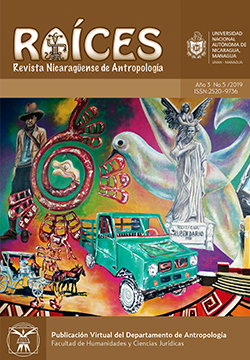Eco-protective dynamics: Healing and Apache in Nandayuri as a good living system
DOI:
https://doi.org/10.5377/raices.v3i5.8802Keywords:
indigenous community, Nandayuri, community dynamics, community protagonists, good livingAbstract
This article reflects on the concepts of community protagonism and the dynamics of Eco Protector and of Sanación and Apache investigated in the community in the Comarca Nanadayuri that is part of the territory of the Indigenous People of Monimbó. As a field of study, the indigenous community has been chosen, because the purpose is to demonstrate that living well is a model of life and practice still existing in many of the indigenous cultures of Nicaragua, as well as in Latin America, although called in different way or simply practiced and not conceptualized. Listening to the voice of its population, an attempt is made to interpret the conception of desirable life in Nandayuri, registering knowledge and practices about its biological and cultural resources (biocultural heritage), values and knowledge, which are mostly transmitted and based on the oral tradition and therefore are at risk of getting lost and disappearing.
Downloads
744
References
Bresó, García Javier. (1992) Identidad y Cultura en Nicaragua: estudio antropológico de Monimbó. Tesis Universidad Complutense. Ediciones de la Universidad de Castilla-La Mancha, D.L.
González Pérez, Miguel. (1997) Gobiernos pluriétnicos: La constitución de las regiones autónomas en Nicaragua. Estudio sobre el Estado nacional y el proceso de autonomía regional en la Costa Atlántica- Caribe. URACCAN/ Plaza y Valdés. México.
Niemel, K, Román, M, Salgado, S. (1998). Las Secuencias Cerámicas de los Periodos Sapoa (800-350 d.c) y Ometepe (1350-1522 d.c) en el Pacífico Sur de Nicaragua. En XI Simposio de investigaciones Arqueológicas en Guatemala, 1977 (editado por J.P. Laporte y H, Escobedo).
Santos, B.D. (2010) Refundación del estado en América Latina: Perspectivas desde una epistemología del sur. México: Siglo XXI Editores
Ulloa, L. F. (2010). Dinámicas Comunitarias y unos Parches. Bogotá: S/E.
Ulloa Forero, L. F. (2018). Dinámicas Comunitarias...y unos parches. Bogotá: S/E.
Ulloa Forero, L. F., & Buriti, C. d. (2017). As Dinâmicas Comunitárias: um olhar para as comunidades desde o que as pessoas fazem na sua vida cotidiana. Campina Grande, Paraiba, Brasil: Instituto Nacional do Semiárido, INSA.
Salgado, S, Román, M, Gurrero, E y, Bolaños, A. (2006). Comparación de las Aldeas Nucleadas de Bagaces (300-800 d.C) del Pacífico de Nicaragua.
RAAN map, http://www.aurorabeachfront.com/ nicaragua/maps/m_raan.gif
Sole, Josep Maria, Arasa Raul et al. “Assessment of Climate Change in Nicaragua, Earth and Environmental Journal, Vol ^ number 3, July 2016, Pages 445-474, http://www.scirp.org/journal/PaperInformation.aspx?paperID=68368, Accessed 24.10.2017
URACCAN, Wikipedia, accessed 16.10.2017
https://en.wikipedia.org/wiki/Demographics_of_Nicaragua#Indigenous_population
https://en.wikipedia.org/wiki/University_of_the_Autonomous_Regions_of_the_Nicaraguan_Caribbean_ Coast accessed 17.10.2017
Von Houwald, Gotz, Mayangna, Edited in German for the Ethnology Museum in Hamburg, Vol. XIX/1990/, Translation into Spanish Edgard Arturo Castro Frenzel.
Downloads
Published
How to Cite
Issue
Section
License
This license enables reusers to distribute, remix, adapt, and build upon the material in any medium or format for noncommercial purposes only, and only so long as attribution is given to the creator. If you remix, adapt, or build upon the material, you must license the modified material under identical terms.




